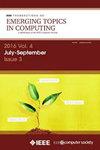Analyzing Wet-Neuromorphic Computing Using Bacterial Gene Regulatory Neural Networks
IF 5.4
2区 计算机科学
Q1 COMPUTER SCIENCE, INFORMATION SYSTEMS
IEEE Transactions on Emerging Topics in Computing
Pub Date : 2025-03-04
DOI:10.1109/TETC.2025.3546119
引用次数: 0
Abstract
Biocomputing envisions the development computing paradigms using biological systems, ranging from micron-level components to collections of cells, including organoids. This paradigm shift exploits hidden natural computing properties, to develop miniaturized wet-computing devices that can be deployed in harsh environments, and to explore designs of novel energy-efficient systems. In parallel, we witness the emergence of AI hardware, including neuromorphic processors with the aim of improving computational capacity. This study brings together the concept of biocomputing and neuromorphic systems by focusing on the bacterial gene regulatory networks and their transformation into Gene Regulatory Neural Networks (GRNNs). We explore the intrinsic properties of gene regulations, map this to a gene-perceptron function, and propose an application-specific sub-GRNN search algorithm that maps the network structure to match a computing problem. Focusing on the model organism Escherichia coli, the base-GRNN is initially extracted and validated for accuracy. Subsequently, a comprehensive feasibility analysis of the derived GRNN confirms its computational prowess in classification and regression tasks. Furthermore, we discuss the possibility of performing a well-known digit classification task as a use case. Our analysis and simulation experiments show promising results in the offloading of computation tasks to GRNN in bacterial cells, advancing wet-neuromorphic computing using natural cells.利用细菌基因调控神经网络分析湿神经形态计算
生物计算设想使用生物系统开发计算范式,范围从微米级组件到细胞集合,包括类器官。这种范式转变利用了隐藏的自然计算特性,开发了可以在恶劣环境中部署的小型化湿计算设备,并探索了新型节能系统的设计。与此同时,我们见证了人工智能硬件的出现,包括旨在提高计算能力的神经形态处理器。本研究通过关注细菌基因调控网络及其向基因调控神经网络(GRNNs)的转化,将生物计算和神经形态系统的概念结合在一起。我们探索了基因调控的内在属性,将其映射到基因感知器函数,并提出了一种特定于应用的子grnn搜索算法,该算法将网络结构映射到匹配计算问题。以模式生物大肠杆菌为重点,首先提取碱基grnn并验证其准确性。随后,对衍生的GRNN进行了全面的可行性分析,证实了其在分类和回归任务中的计算能力。此外,我们讨论了执行一个众所周知的数字分类任务作为用例的可能性。我们的分析和模拟实验显示,在将计算任务卸载给细菌细胞中的GRNN方面取得了可喜的结果,从而推进了使用自然细胞的湿神经形态计算。
本文章由计算机程序翻译,如有差异,请以英文原文为准。
求助全文
约1分钟内获得全文
求助全文
来源期刊

IEEE Transactions on Emerging Topics in Computing
Computer Science-Computer Science (miscellaneous)
CiteScore
12.10
自引率
5.10%
发文量
113
期刊介绍:
IEEE Transactions on Emerging Topics in Computing publishes papers on emerging aspects of computer science, computing technology, and computing applications not currently covered by other IEEE Computer Society Transactions. Some examples of emerging topics in computing include: IT for Green, Synthetic and organic computing structures and systems, Advanced analytics, Social/occupational computing, Location-based/client computer systems, Morphic computer design, Electronic game systems, & Health-care IT.
 求助内容:
求助内容: 应助结果提醒方式:
应助结果提醒方式:


